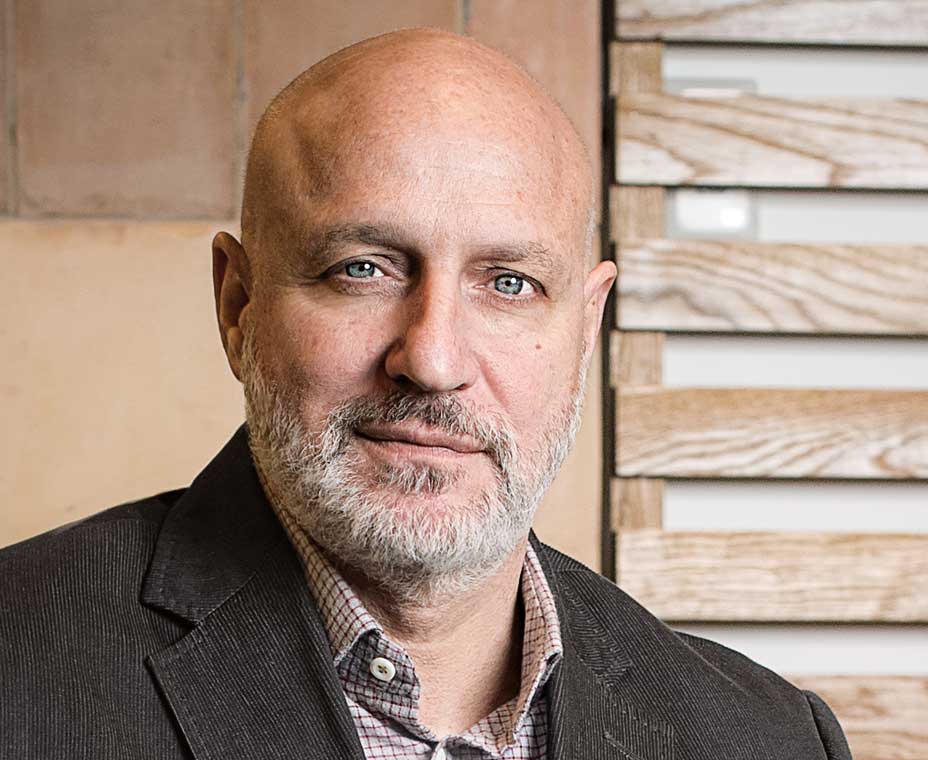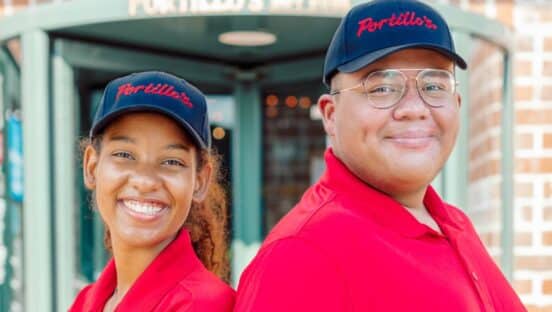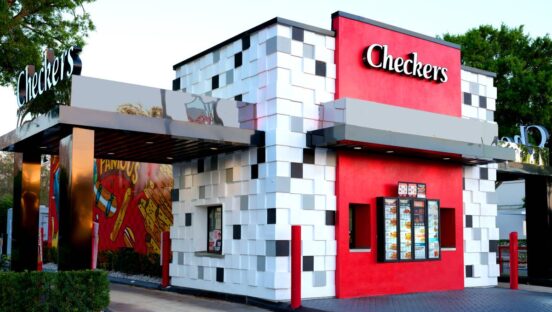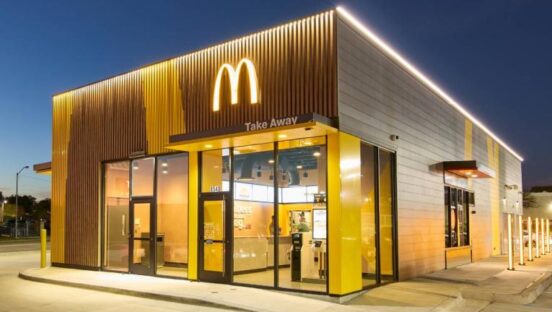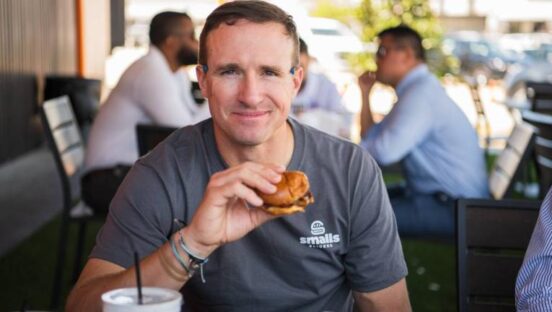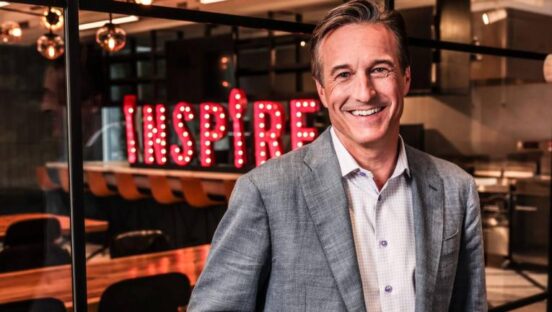It’s raining in New York, and cold. Streams of Manhattan residents and workers flow along Broadway in the East Tribeca neighborhood, huddled against a bitter February wind, umbrellas fighting for sidewalk space.
At the corner of Broadway and Worth, though, warm light illuminates the dreary morning, pouring from floor-to-ceiling glass windows. Through sheer windowpanes, passersby can see into an open two-story space decorated with green panels, slatted wood, and terracotta tiles. They can see a neatly organized menuboard hanging above a narrow, rectangular window that offers a peek into a kitchen. They can see a make line that has become emblematic of the fast casuals lining so many U.S. city streets.
On this particular weekday morning, the restaurant is closed—a pesky permitting issue that’s quickly resolved—but that doesn’t stop several shivering New Yorkers from trying to duck into the space. Those who pull open the one unlocked door are politely turned away. Others gape in the windows.
No doubt some of the gapers study the man who hovers near the front door. He wears a corduroy blazer and a gray beard. One sharply dressed 20-something who makes it into the restaurant, oblivious to requests to please come back later, sees the bearded man and, as if they were due to meet, strides up, extends his hand, and introduces himself.
“Hi,” the bearded man replies. “I’m Tom.”
The 20-something is quiet a second, reflective. Then he says, “I’ve seen you on TV,” and adds as the bearded man nods, “You’re the guy from ‘Top Chef.’”
It’s a fairly common experience for Tom Colicchio. After all, he’s recognizable in New York, a city he’s lived and cooked in for three decades, and he’s recognizable across the globe as the head judge of one of the most popular food shows on TV.
One thing Colicchio is not recognized for, though, is sandwiches. Nor is he recognized, like some of his peers, as a trailblazing chef in the fast-casual space. But if he and business partner Sisha Ortuzar succeed at replicating the brightly lit February refuge in East Tribeca—the newest location and prototype for ’Wichcraft, their 14-year-old sandwich fast-casual brand—that might soon change.
Too far ahead of the curve
Free of the wayward New Yorkers, Colicchio and Ortuzar offer a tour of the new ’Wichcraft prototype. The restaurant, open since July, is spacious, with about 30 seats lining table space along the outer wall. A countertop with living greens reaches out into the middle of the dining room. The multi-green posters on the walls are an orderly mosaic, with food-forward slogans bursting out in various fonts: “Nature Made, Chef Prepared.” “Hand Farmed, Hand Made, Hand Held.” “Break Bread, Build Sandwich.”
It’s a striking visual change from what the brand used to be.
The first ’Wichcraft opened in 2003, two years after Colicchio opened Craft, a James Beard Award–winning restaurant that redefined high-quality, seasonal ingredients in the fine-dining world. As the story goes, a space became available next door to Craft and its sister restaurant, Craftbar. The lease was favorable, and Colicchio and his team wanted to do something that was cheaper and focused on a daypart other than dinner.
They rented the space and opened a sandwich shop.
“We had this great halo effect: Sisha was making every sandwich every day, I was often in the store, [and] Karen DeMasco, our pastry chef at Craft, was doing all the baking,” Colicchio says as he perches on a stool next to the living-greens counter. “We felt like most restaurants do—because we come from the restaurant side of things—that you just put out great food and the rest takes care of itself.”
And for a while, it did. ’Wichcraft thrived on a farm-to-table fast-casual model long before farm to table and fast casual were household terms. Its first year was a year before Shake Shack made its debut, and the same year Chipotle opened its first location in New York; lunch options in the city were far different than the vast number of premium fast-casual options available today.
Eventually, the brand grew to nearly 20 locations. That included a shop in Las Vegas—next to Colicchio’s Craftsteak at the MGM Grand—and one in San Francisco. National expansion seemed the next logical step.
But reality caught up to the company. One of the original chef-driven fast casuals, ’Wichcraft was almost too far ahead of the curve, and business started to go south. Before the East Tribeca location opened, the brand hadn’t opened a new location in six years. Several, including the shops in San Francisco and Las Vegas, closed. Nine are open today, counting the new prototype; all are in New York.
“It was a point in our business where we had to make some drastic changes because we were starting to fall behind,” Colicchio says. “We were starting to see some stores not work out. That’s the thing: It wasn’t just about rebranding and redesigning the stores. … It was more of a ‘We need to grow up.’ We were treating it like a restaurant, and it’s not a restaurant. It’s a different business.”
“You have to approach it in a different way; you have to communicate a different way, from the supply chain to the real estate and development,” Ortuzar adds. “That happened gradually, until the point where we were like, ‘We really need to stop what we’re doing and do the right thing.’”
That included a massive brand overhaul. Colicchio’s team enlisted Mapos, an architect and design firm, to refresh ’Wichcraft’s store design, and hired graphic-design specialist Tag Collective to work on the branding. The two firms worked together to reinvent the ’Wichcraft experience, developing a look and a message that conveyed to guests the concept’s use of high-quality, local ingredients.
The problem, both Colicchio and Ortuzar say, was that beyond a name and a (very simple) logo, they’d not put enough time into developing the ’Wichcraft brand. They’d also never considered how ’Wichcraft’s physical space could complement the premium sandwich menu.
“We thought [the stores] looked great, but they didn’t tell anybody who we were, what we were doing—in fact, you couldn’t even tell we were making sandwiches,” Colicchio says. “So we knew that we had to start focusing on our message and our brand, and that we had to do it through our stores and through smart design.”
The redesigned stores now scream fresh food, with the many shades of green, the clever slogans, and graphics portraying vegetables, kitchen utensils, even a honeycomb with bees; the new logo sports a drawing of a hand holding a root vegetable.
This kind of messaging is critical for fast-casual brands that want to communicate quality to their customers, says Denise Lee Yohn, a brand consultant and author of What Great Brands Do (and former QSR columnist). She says that especially for chefs who are developing fast-casual concepts, it’s important they translate their fine-dining pedigree to a message easily discernible to the lay eater.
“There needs to be some connecting the dots for people so that you’re not talking over them about the ingredients you use or flavor profiles or cooking practices—you need to do that in a way that more of a mainstream customer understands,” she says.
And the mainstream customer is exactly who Colicchio, Ortuzar, and the rest of the ’Wichcraft team hope to target.
In search of mass-market appeal
A chef of Colicchio’s caliber entering the fast-casual market is nothing new. Several fine-dining chefs have opened limited-service concepts, many of them with James Beard Awards and TV credits alike. José Andrés opened Beefsteak. Rick Bayless has Xoco and Tortas Frontera. And Danny Meyer, with whom Colicchio opened famed New York restaurant Gramercy Tavern in the 1990s, is now a millionaire many times over after growing Shake Shack into one of the premier better-burger joints and taking it public.
This emerging category—the fast casual 2.0 space defined by chef-driven food, premium hospitality, and a casual-dining vibe—is propelled by food-conscious consumers who closely follow local and celebrity chefs and yet don’t have the kind of disposable income to dine at their restaurants with any frequency.
“It’s all become very mainstream at this point, where people are much more aware of the popular name-brand chefs,” Yohn says. “But a lot of people either don’t want to spend the money or don’t have the money to indulge in these kinds of luxury, upscale restaurant experiences, so putting them in a fast-casual format really makes it very accessible to them.”
That potential mass-market appeal is one of the reasons the ’Wichcraft team is retooling the concept. But Colicchio’s story is unique in that he’s taking sort of a backward approach to becoming the next fast-casual darling. Whereas many chefs develop a fast-casual concept and engineer the food around the concept, he says, ’Wichcraft always had a stellar menu—it simply didn’t have the right concept.
With the food and concept pieces in perfect harmony, the hope is that the ’Wichcraft brand would find much stronger traction in the broader consumer market.
“There are a lot of people who are really into food and know Tom and would like to be able to taste [his food], and this affords them an opportunity to be able to do that,” Ortuzar says. “But it also allows us an opportunity to be present in a lot more places than we could with just one restaurant.”
While many Americans know him simply as the judge on “Top Chef,” Colicchio had established his fine-dining chops long before the show debuted on Bravo in 2006. A New Jersey native, he moved to New York and made a name for himself cooking at esteemed restaurants like The Quilted Giraffe, Gotham Bar & Grill, and Rakel.
Colicchio and Meyer burst onto the national dining scene in 1994 when they opened the award-winning and massively popular Gramercy Tavern (Meyer still owns the restaurant, while Colicchio sold his stake in 2006). Craft opened in 2001, and Colicchio’s company, Crafted Hospitality, has since added restaurants all over the country, including Craft Los Angeles, Fowler & Wells, Riverpark, Beachcraft, Craftsteak, and Heritage Steak.
With these renowned restaurants, a widespread TV personality, five James Beard Awards, three cookbooks, and acclaim even in the food-policy world (he cofounded Food Policy Action, which speaks out on food issues, and also produced a documentary on hunger in America, “A Place at the Table,” with his filmmaker wife, Lori Silverbush), it would be understandable if Colicchio simply handed off the ’Wichcraft makeover to others and took a back seat for the redevelopment phase.
But that’s not who he is. Take it from Andy Fortgang, co-owner of the restaurants Le Pigeon and Little Bird in Portland, Oregon. Fortgang started his career working for Colicchio, first at Gramercy Tavern and later at Craft, where he was the beverage director when the first ’Wichcraft opened. He says Colicchio is very direct in correcting any mistakes and getting to the heart of any issue that’s disrupting an enjoyable customer experience.
“Tom is very forthright and pragmatic guy,” he says. “That sounds basic, but those are qualities that most people don’t really live by. … Tom is really good at seeing what the central issue is and focusing on that.”
‘A Meal Between 2 Pieces of Bread’
A large green sign hangs in the window of the new ’Wichcraft, above a shelf holding carefully stacked branded merchandise. From the inside, the sign reads: “True to Our Roots.” From the outside, it reads: “A Meal Between 2 Pieces of Bread.”
Colicchio and Ortuzar know the sandwich market is crowded. From Subway and Arby’s on the quick-service side to Jersey Mike’s and Firehouse Subs in fast casual and Mendocino Farms and Homegrown Sustainable Sandwiches in fast casual 2.0, there’s no shortage of concepts competing for customers’ sandwich business.
But ’Wichcraft, the business partners believe, has something that other brands do not: the best ingredients combined in some of the most creative sandwiches available in a limited-service format.
“It’s providing that package that everyone is familiar with and making it new and making it different,” Colicchio says, “but knowing that as much thought went into making that delicious as we do with a $50 entrée.”
Indeed, ’Wichcraft has always boasted a menu unlike any other sandwich chain. Today’s signature sandwiches include options like the Bristol Bay Wild Salmon Torta, with black beans, avocado, chopped romaine, and aji verde sauce on ciabatta, and the Chickpea Hummus, with seasonal vegetable salad, tahini, za’atar, and mint pesto on ciabatta. There are also pressed sandwiches like the Heritage Smoked Ham with pear-cranberry chutney, Dijon mustard, and aged cheddar on country bread, and the Flank Steak with romesco, grilled scallions, and aged cheddar on country bread.
The new-prototype menu is expanded. There are now organic egg bowls and organic egg sandwiches available for breakfast, as well as new salad and grain-bowl options. Signature sandwiches have been added, as well as a “Craft Your ’Wich” option for guests who wish to customize their meal. There’s now beer, wine, and organic soda, and Ice Cream’wiches for dessert.
“What we want to provide in terms of flavor profile and experience is something in the middle of delicious and feels good,” says Ortuzar, who is also a chef. “We like to make interesting combinations and well-prepared food and things that you might not see elsewhere. That’s part of the experience.”
But premium sandwiches don’t come easy. Beyond branding and messaging, the original ’Wichcraft iteration struggled to meet the fast-casual expectations of speed and convenience. Fortgang, the former Craft beverage director, reflects on the first month ’Wichcraft was open in 2003 and how he’d go there for lunch and have to wait forever to get his sandwich. “It always felt like a [fine-dining] restaurant but where you ordered at the counter,” he says.
Colicchio says ’Wichcraft was averaging 10–12-minute wait times—way more than standard limited-service brands, even those with a chef-driven menu. The make line and kitchen setup, which weren’t organized well or optimized for rush hours, were partly to blame; front-line employees would “grab a sandwich and kind of move all over the place,” he says.
The new prototype was designed with efficiency in mind. The facility and kitchen were reorganized according to Ortuzar’s own design. A window into the kitchen allows for expediting at peak hours, and an assembly-line process keeps things moving quickly.
“When we’re at peak, we’re running two lines, and when it slows down we can flex over to one,” Colicchio says. “So we can deal with labor in an effective way. Now our times are down to 4–5 minutes, because it’s more of an assembly, straight down from bread to wrapping.”
A league of its own
The fast casual 2.0 category is still in its infancy. The concept of fine dining–quality ingredients and hospitality available in a fast-casual setting has mostly taken off in the last five years as post-recession disposable income has climbed and consumers have sought high-quality experiences that are more affordable and convenient.
’Wichcraft, though, is in a league of its own. The 14 years in its rearview mirror have seasoned the brand and its leadership team, and the mistakes they’ve made along the way have prepared them for whatever might come next. That, Colicchio says, benefits the company as it plots expansion once more outside of New York.
“A lot of chefs that get into the fast-casual side of things want to grow fast, and I think they’re going to realize that there’s a lot of speed bumps along the way that will really get you in trouble if you don’t take a step back and slow down a little bit,” he says. “Growth for growth’s sake is not a good idea. And I think that’s also part of our learning curve, too.”
Colicchio and Ortuzar are targeting the eastern seaboard for initial growth, looking at Boston, Philadelphia, Baltimore, and Washington, D.C., for opportunities. Their growth strategy has evolved along with the brand; whereas before they thought they’d need to first enter a market with one of Crafted Hospitality’s fine-dining concepts, they’re now confident they can enter a market with ’Wichcraft.
The only catch, Ortuzar says, is that they can’t just test the waters of a new city; they have to jump in whole-hog. “Once we go into a market, we have to open more than one location relatively soon,” he says. “Just operating one location is not enough, because we need an operations team who can handle our stores.”
The team isn’t oblivious to the fact that fast-casual competition around the country is tough. Not only are there several other high-quality sandwich concepts out there, but there are also hundreds of other fast-casual brands seeking the same customers, real estate, and investment dollars as ’Wichcraft.
Now that they’ve perfected the fast-casual recipe, though, they’re optimistic ’Wichcraft can finally become the success they hoped it could be.
“We say that we do one thing, and if we can accomplish this, we’re going to be successful: that’s making people happy,” Colicchio says. “If we can do that through the experience of being in the store, through the experience of getting great food, through the experience of having that transaction be very smooth, then I think we’re accomplishing our goal.”

